
An economist is an expert who will know tomorrow why the things he predicted yesterday didn’t happen.
– Earl Wilson
Jobs Update
- Initial jobless claims for the week ending April 2nd, 2022 came in at 166,000, down -5,000 people week-over-week.
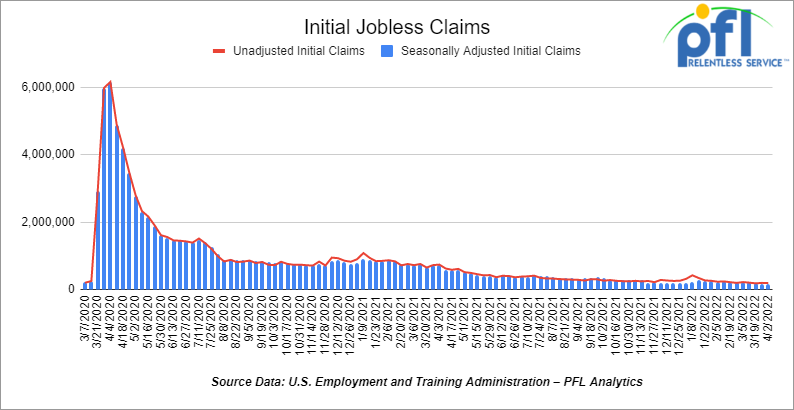
- Continuing claims came in at 1.523 million people versus the adjusted number of 1.506 million people down -17,000 people week-over-week.
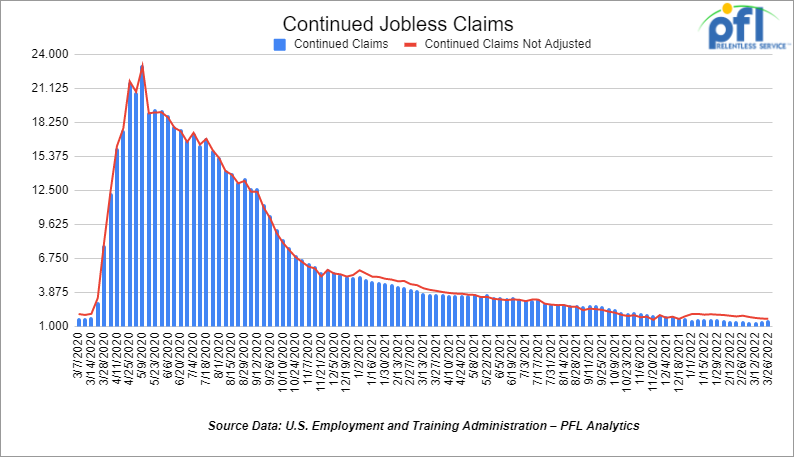
Stocks were mixed on Friday of last week, but were down week-over-week
The DOW closed higher on Friday of last week, up 137.55 points (0.40%), closing out the week at 34,721.12 points, down -97.15 points week-over-week. The S&P 500 closed lower on Friday of last week, down 11.93 points, and closed out the week at 4,488.28, down -57.58 points week-over-week. The Nasdaq closed lower on Friday of last week, down 186.3 points (-1.34%), and closed out the week at 13,711, down -550.5 points week-over-week.
In overnight trading, DOW futures traded lower and are expected to open at 34,536.00 this morning down -77.00 points.
Oil closed higher on Friday of last week but lower week over week
Oil prices rose two percent on Friday of last week, but notched their second straight weekly decline after countries announced plans to release crude from their strategic stocks. U.S. West Texas Intermediate (WTI) crude futures rose $2.23 to $98.26 per barrel. Brent crude futures settled up $2.20, or 2.19 percent, at US$102.78/bbl. For the week, Brent dropped 1.5% while WTI slid 1%. For several weeks, the benchmarks have been at their most volatile since June 2020. Phil Flynn, an analyst at Price Futures Group said “There’s some concern that by artificially lowering prices, you are only going to increase demand and that’s going to burn off that supply pretty quickly.” We agree with Phil – drawing reserves without a backup plan is pointless. We need to start drilling up North America and quickly, but we hear nothing but crickets when the questions are asked. In fact, it is the same old same old – let’s shut down existing pipelines and not approve new ones!
U.S. commercial crude oil inventories (excluding those in the Strategic Petroleum Reserve) increased by 2.4 million barrels week-over-week. At 412.4 million barrels, U.S. crude oil inventories are 14% below the five-year average for this time of year.

Total motor gasoline inventories decreased by 2.0 million barrels week-over-week and are 1% below the five-year average for this time of year.
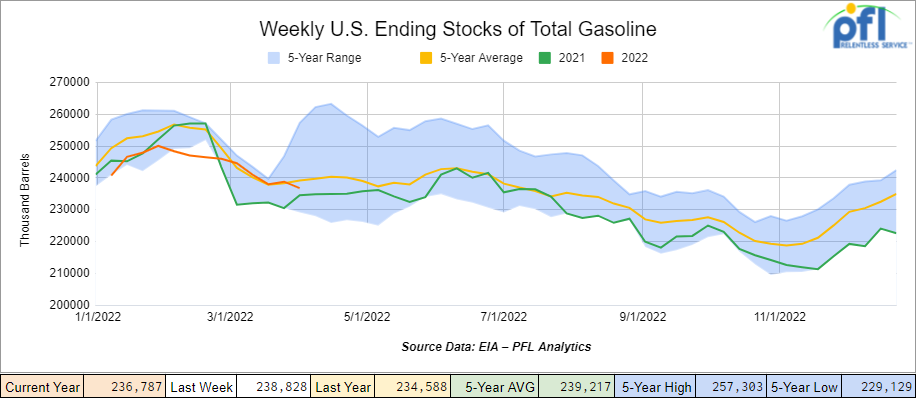
Distillate fuel inventories increased by 800,000 barrels week-over-week and are 15% below the five-year average for this time of year
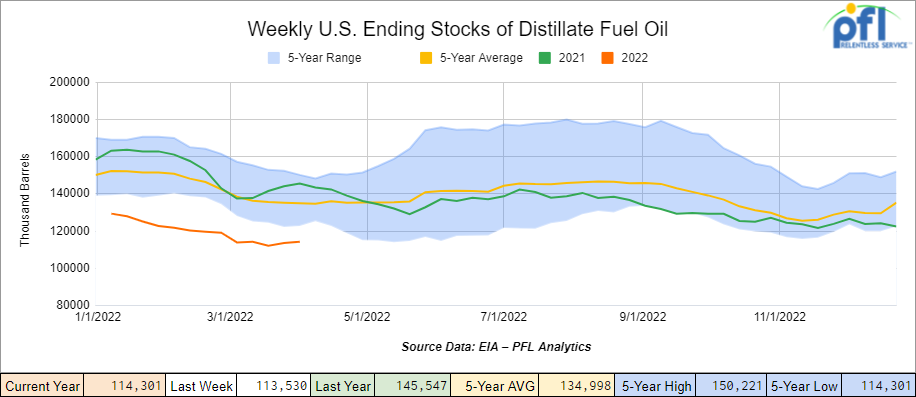
Propane/propylene inventories increased by 700,000 barrels week-over-week and are 21% below the five-year average for this time of year.
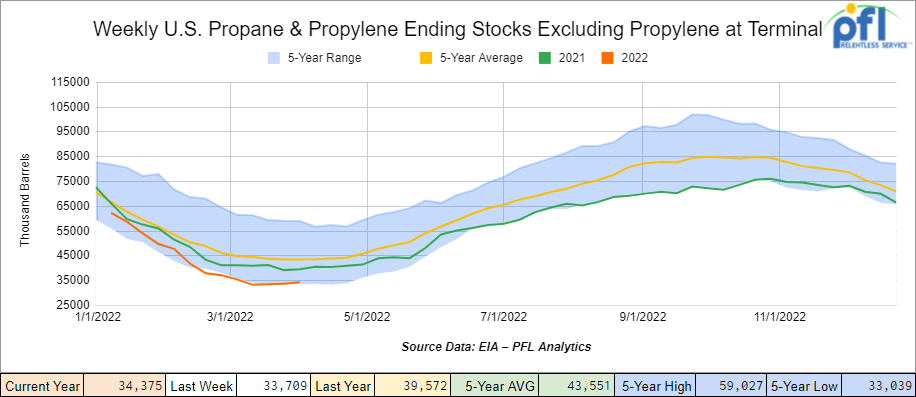
Propane prices fell slightly week over week losing 4 cents a gallon, but up 51 cents a gallon year over year.
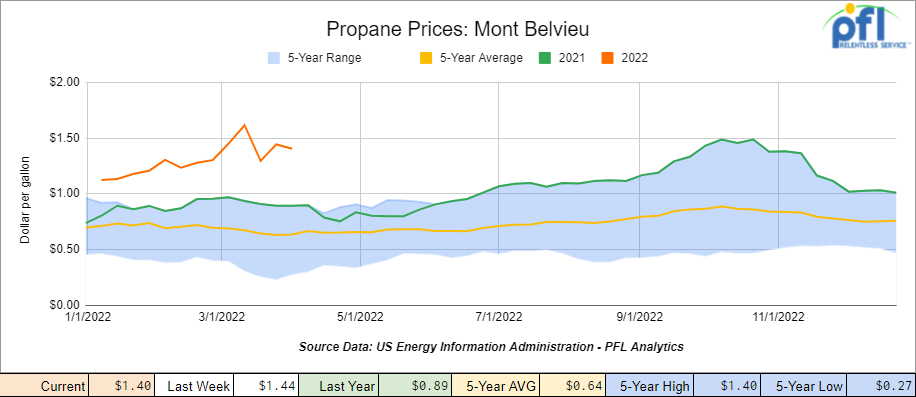
Overall, total commercial petroleum inventories increased by 5.2 million barrels for the week ending April 1, 2022.
U.S. crude oil imports averaged 6.3 million barrels per day for the week ending April 1, 2022, up by 41,000 barrels per day week over week. Over the past four weeks, crude oil imports averaged about 6.4 million barrels per day, 8.9% more than the same four-week period last year. Total motor gasoline imports (including both finished gasoline and gasoline blending components) averaged 484,000 barrels per day, and distillate fuel imports averaged 88,000 barrels per day for the week ending April 1, 2022.
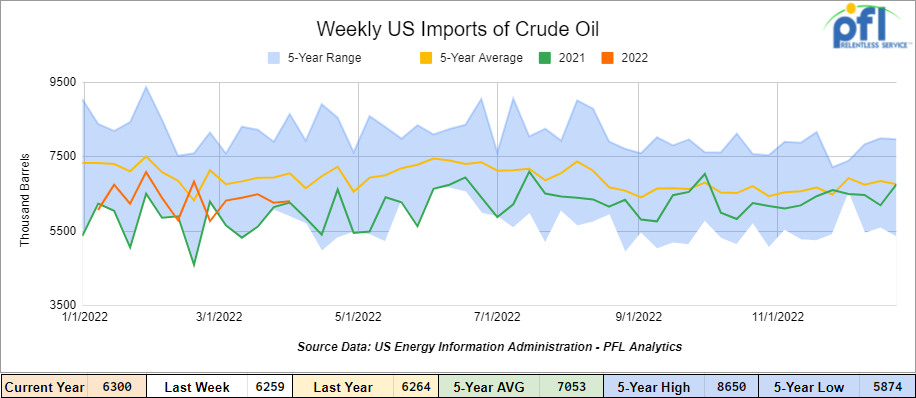
U.S. crude oil refinery inputs averaged 15.9 million barrels per day during the week ending April 1, 2022, which was 35,000 barrels per day more week over week.
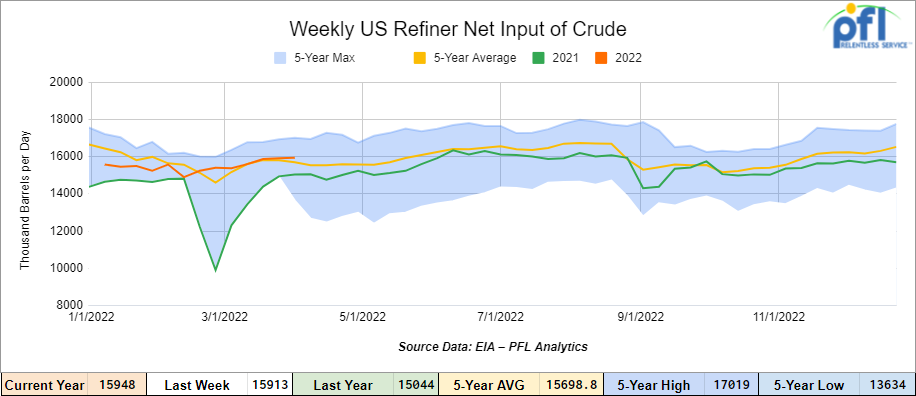
As of the writing of this report, WTI is poised to open at 96.24, down -2.02 per barrel from Friday’s close.
North American Rail Traffic
Total North American rail volumes were down 0.5% year-over-year in week 13 (U.S. -2.7%, Canada +0.9%, Mexico +30.5%) resulting in 1Q22 volumes finishing down 3.7% year-over-year (U.S. -2.7%, Canada -9.4%, Mexico +5.4%). 5 of the AAR’s 11 major traffic categories posted year-over-year declines with the largest decreases coming from intermodal (-3.5%) and grain (-19.7%). The largest increases came from coal (+10.6%) and chemicals (+8.6%).
In the East, CSX’s total volumes were up 2.6%, with the largest increases coming from coal (+11.0%) and motor vehicles & parts (+21.0%). NS’s total volumes were down 3.6% year-over-year, with the largest decreases coming from intermodal (-2.8%), coal (-9.9%) and metals & products (-19.1%).
In the West, BN’s total volumes were down 5.6%, with the largest decreases coming from intermodal (-8.3%), grain (-20.5%), and petroleum (-16.6%). UP’s total volumes were up 2.5%, with the largest increases coming from coal (+46.1%) and chemicals (+11.8%). The largest decreases came from intermodal (-5.3%) and grain (-13.0%).
In Canada, CN’s total volumes were up 4.1%, with the largest increases coming from coal (+108.5%), petroleum (+37.6%), and chemicals (+12.3%). The largest decreases came from intermodal (-4.4%) and grain (-28.6%). Revenue per ton-miles was up 6.8%. CP’s total volumes were down 1.4%, with the largest decrease coming from grain (-36.4%). The largest increases came from coal (+23.2%) and intermodal (+4.8%). Revenue per ton-miles was down 4.5%.
KCS’s total volumes were up 4.2%, with the largest increases coming from grain (+47.8%) and motor vehicles & parts (+61.5%). The largest decrease came from petroleum (-28.6%).
Source: Stephens
Rig Count
North American rig count is up by 3 rigs week over week. U.S. rig count was up by 16 rigs week-over-week and up by 257 rigs year over year. The U.S. currently has 689 active rigs. Canada’s rig count was down by -13 rigs week-over-week and up by 53 rigs year-over-year and Canada’s overall rig count is 111 active rigs. Overall, year over year, we are up 310 rigs collectively.
North American Rig Count Summary

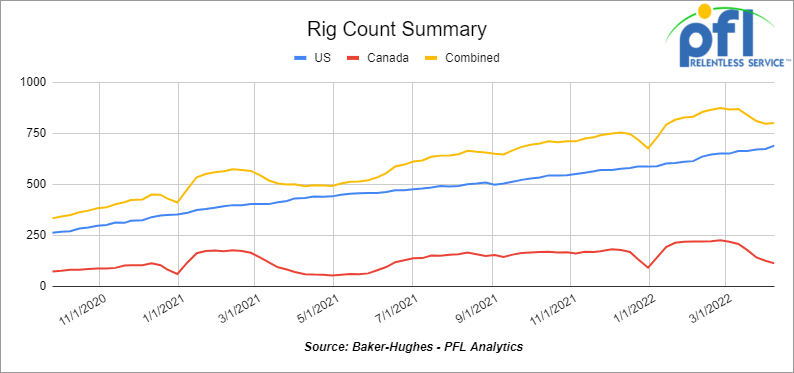
A few things we are keeping an eye on:
Petroleum Carloads
The four-week rolling average of petroleum carloads carried on the six largest North American railroads fell to 23,363 from 23,902, which is a loss of 539 rail cars week-over-week. Canadian volumes were mixed: CP shipments were up by 11.3% while CN volumes were down by 13.2%. U.S. volumes were also mixed with the UP having the largest percentage increase (up by 2.6%) The NS had the largest percentage decrease down by 5.1%.
Some Key Economic Indicators
Purchasing Managers Index (“PMI”) – The PMI (which covers manufacturing) and the Services PMI (covering services) are both from the Institute for Supply Management. They are based on surveys of supply managers around the country. The surveys track the direction of changes in business activity. An index reading above 50% indicates expansion; below 50% means contraction. The more above or below 50, the faster the pace of change.
The PMI fell from 58.6% in February to 57.1% in March. That’s the 22nd straight month above 50%, but it’s below what most economists expected and is the lowest reading since September 2020. The new orders component of the PMI fell to 53.8% in March, down sharply from 61.7% in February and the lowest it’s been since May 2020.
Tim Fiore, who manages the PMI, appears on Manufacturing Talk Radio and talks in depth about the current month’s PMI. In the interview on the March index, Fiore cited three factors behind the fall in new orders in March. First, export orders were down due, he thinks, to the uncertainty created by the war in Ukraine and the lockdowns in China. Second, lead times remain long and prices are up sharply. Third, Fiore says the seasonal adjustment factors applied in March were based on historical patterns, but they might have created some distortions because March this year was not a typical March. Fiore said he expects new orders to rebound in April.
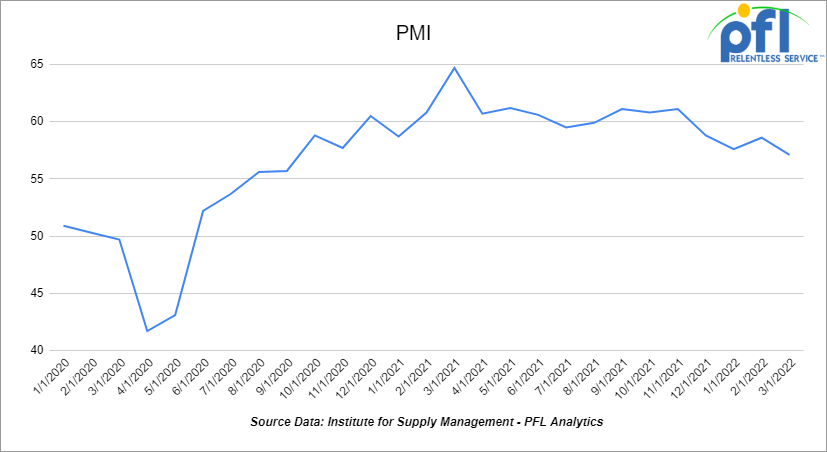
Based on preliminary data from the Federal Reserve, U.S. industrial output in February 2022 was the highest since December 2018 — 0.5% higher than in January 2022 and 7.5% higher than in February 2021 (when severe winter weather significantly impacted industrial activity). The peak month for U.S. industrial output was August 2018; output in February 2022 was close to that level.
Manufacturing, which accounts for around 75% of total output, rose a preliminary 1.2% in February from January, thanks to gains in (among others), grain mill products (up 3.1% — output in February was the highest since June 2016); lumber and wood products (up 2.6%, highest output since 2008); refined petroleum products (up 2.2%, highest output since early 2020); and railroad rolling stock (up 2.0%).

The Conference Board’s index of consumer confidence rose to 107.2 in March 2022 from 105.7 in February. It remains well below where it was at the end of 2021 and ever further from its recent peak in the summer of 2021. We do expect consumer confidence to trend lower as due to the continued war in Ukraine and rising costs of pretty much everything.
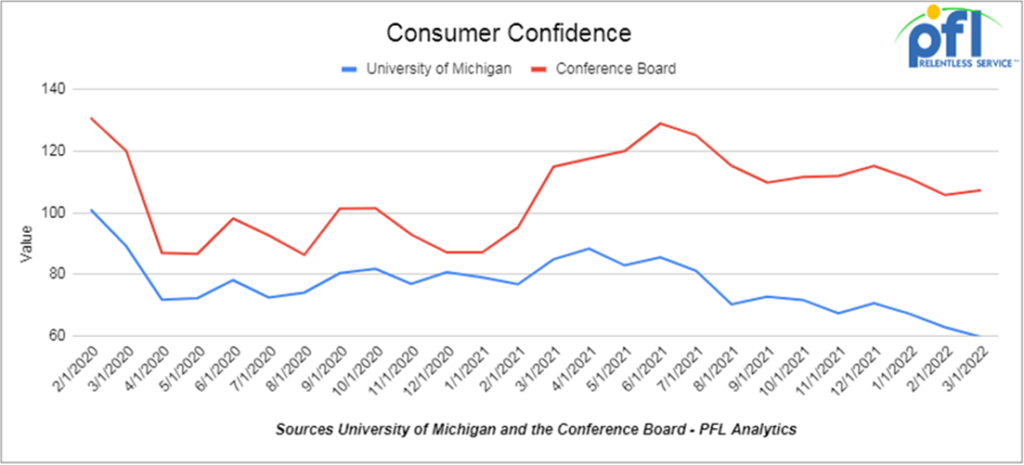
Consumer spending rose at a seasonally adjusted, non-inflation adjusted rate of 0.2% in February 2022 over January 2022, a big slowdown from the 2.7% increase in January from December, but much better than the 0.9% decline in December from November.
Adjusted for inflation, total spending fell 0.4% in February from January and its third decline in the past four months.

We have been extremely busy at PFL with return on lease programs involving rail car storage instead of returning cars to a shop. A quick turnaround is what we all want and need. Railcar storage in general has been extremely active. Please call PFL now at 239-390-2885 if you are looking for rail car storage, want to troubleshoot a return on lease scenario, or have storage availability. Whether you are a car owner, lessor or lessee, or even a class 1 that wants to help out a customer we are here to “help you help your customer!”
Leasing and Subleasing has been brisk as economic activity picks up. Inquiries have continued to be brisk and strong Call PFL Today for all your rail car needs 239-390-2885
PFL is seeking:
- 5, 29k Tank Cars needed in Texas off of the KCS for 5 years. Need to be lined.
- Up to 40 5500 Covered Gons 286 unlined CSX/NS preferred but will consider other
- 30 boxcars on UP or CP for 3 years to run from TX to Edmonton – negotiable
- 6-10 Open top 4200 gons for hauling scrap NS in Ohio for 1-3 years
- 100, 2480 CU-FT Ag Gons needed in Texas off of the UP for 1-3 Years.
- 50, 30K+ Tank cars are needed in several locations. Can take in various locations off various Class 1’s. Can have prior Ethanol heel or Gasoline heel.
- 300 5800 Covered hoppers needed for plastic – 5-year lease – negotiable
- 50 29K C&I Tanks for veg oil to purchase – Immediate need
- 15 5200-5500 PD hoppers in the west UP for 5 years for soda ash negotiable
- 30 5800 and 6250 covered gons for sale
- 50, 5800cuft or larger Covered Hopper for use in DDG needed in the Midwest for 3-4 years. Immediate need.
- 10-20 Covered hopper grain cars in the Midwest 5200-5500 2-3 years
- 20-30, 19K Tank Cars for Caustic Soda needed in Texas off of the UP or BN.
- 100 Moulton Sulfur cars for purchase – any location – negotiable
- 12 Plate F 286 GRL Boxcars 12’ plug doors Midwest preferred for a 1-year lease
- 30-50 Log Flats with stanchions 286K GRL in the Midwest/east CSX NS 1-3 years negotiable
- 50 Ag Gons 2500-2800cuft 286k GRL in the east CSX for 5 years negotiable
- 25 Covered wood chip Gons 6000 CF 286 GRL any location for 1-3 years negotiable
- 25 Boxcars for paper 6000CF 286 GRL 1-3 years anywhere
- 100 15K Tanks 286 for Molten Sulfur in the Northeast CSX/NS for 6 months negotiable
- 100, 5800 Covered Hoppers 286 can be West or East for Plastic 3-5 years
- 70, 117R or J needed for Ethanol for 3 years. Can take in the South.
- 50, 6500+ cu-ft Mill Gon or Open Top Hopper for wood chips in the Southeast for 5 Years.
- 25 bulkhead flats 286 any class one for up to 5 years Negotiable
- 20, 19,000 Gal Stainless cars in Louisiana UP for nitric acid 1-3 years – Oct negotiable
- 10, 6,300CF or greater covered hoppers are needed in the Midwest.
- 2, 89’ Flatcars for purchase or lease – needed in TX off the BNSF
PFL is offering:
- Various tank cars for lease with dirty-to-dirty service including, nitric acid, gasoline, diesel, crude oil, Lease terms negotiable, clean service also available in various tanks and locations including Rs 111s, and Js – Selection is Dwindling. Call Today!
- 200 Clean C/I 25.5K 117J in Texas. Brand New Cars!
- 150 25.5 111’s in the Midwest for sale – Negotiable
- Up to 150 sand cars for sale at various locations and class ones – Great Price!
- 150 117R’s 31.8 clean for lease in Texas KCS – negotiable
- 31.8K Tank Cars last in Diesel. Dirty to dirty in Texas
- 200 117Js 29K OK and TX Clean and brand new – Lined- lease negotiable
- 100 117Rs dirty last in Gasoline in Texas for lease Negotiable
- 90 117Rs 30K located in Alberta CN or CP Refined Products Dirty – negotiable
- 99 340W Pressure Cars various locations Butane and Propane dirty negotiable
- 100 73 ft 286 GRL riser less deck, center part for sale
- 30 CPC 1232 25.5K C/I Pennsylvania NS clean negotiable
- 100-150 29K C/I 117J cars for lease. Dirty in Bakken crude and can be returned dirty.
- 100 29K C/I 1232 cars for lease. Dirty in Heavy Crude and can be returned dirty.
- 50 29K 117Js in Nebraska for sale or lease clean last in crude
- 100 117Rs 29K clean last used in crude Washington State – price negotiable sale or lease
- 100 111s of various volumes and locations last in fuel oil dirty price negotiable
- Various Hoppers for lease 3000-6250 CF 263 and 268 multiple locations negotiable
- 100 3200 Covered Hoppers for sale price negotiable
Call PFL today to discuss your needs and our availability and market reach. Whether you are looking to lease cars, lease out cars, buy cars or sell cars call PFL today 239-390-2885
PFL offers turn-key solutions to maximize your profitability. Our goal is to provide a win/win scenario for all and we can handle virtually all of your railcar needs. Whether it’s loaded storage, empty storage, subleasing or leasing excess cars, filling orders for cars wanted, mobile railcar cleaning, blasting, mobile railcar repair, or scrapping at strategic partner sites, PFL will do its best to assist you. PFL also assists fleets and lessors with leases and sales and offers Total Fleet Evaluation Services. We will analyze your current leases, storage, and company objectives to draw up a plan of action. We will save Lessor and Lessee the headache and aggravation of navigating through this rapidly changing landscape.
PFL IS READY TO CLEAN CARS TODAY ON A MOBILE BASIS WE ARE CURRENTLY IN EAST TEXAS
Live Railcar Markets
| CAT | Type | Capacity | GRL | QTY | LOC | Class | Prev. Use | Clean | Offer | Note |
|---|
